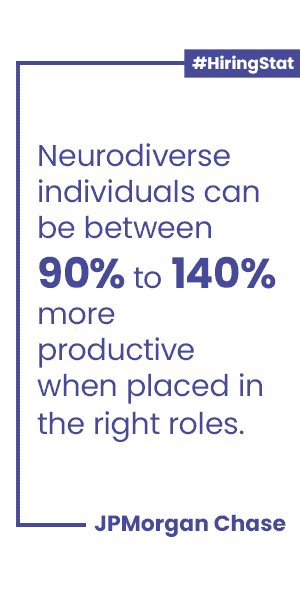Guess what? We are all neurodiverse. Some people think fast, and others think slow. Each of us sees the world differently, may communicate differently, and have different opinions.
Neurodiversity refers to variations in the way some people think. It includes autism, dyslexia, attention deficit hyperactivity disorder (ADHD), and other cognitive differences.
Research shows up to 15-20% of the U.S. population is neurodivergent. This neuro-distinctiveness cuts across all socio-economic lines – and has been around forever. Whether you know it or not, you interact with neurodivergent people daily. They are your family members, friends, neighbors, and co-workers.
However, few employers have tapped the economic growth potential of neurodiversity. Creating a workplace that adapts to employees brings many financial and cultural benefits to businesses. This is known as a neuro-inclusive workplace. It is different from requiring employees to adapt to the work environment.
By supporting neurodiverse workers, and accepting people who may simply think differently, more diverse teams bring balance, drive innovation and creativity.

JPMorgan Chase reports positive results from its Autism at Work initiative. Professionals in the initiative make fewer errors than neurotypical employees. They are also 90-140% more productive.
Neurodiverse people offer unique skills, ideas and talents, such as:
Neurodivergent workers want the same things as other workers. Everyone wants opportunities for career advancement, job satisfaction, personal and professional growth.
Diversity is good for business. Worldwide, Forrester research finds that more diverse organizations were more profitable, and had higher employee engagement and retention rates.
Top companies are hiring and nurturing neurodiverse talent. Twanna Hardy, Chevron’s neurodiversity program manager, made an important observation.
“Neurodiverse individuals have a passion and creative minds,” she said. “This allows them to think and solve problems in unique ways. That’s what every company needs.”
The neurodiversity movement is gaining acceptance for its community, and staffing solutions are emerging to help. Yet many individuals do not feel comfortable enough to disclose neuro-distinctiveness for fear of negative judgment.
A neuro-inclusive workplace is about reframing and recognizing the advantages that different ways of thinking can bring.
To be neuro-inclusive means moving from the “medical model” and understanding that cognitive difference is not a thing that needs to be “cured.” Just like some people are left-handed, neuro-distinctive traits are simply part of who an individual is.
From a business perspective, employers must create staffing solutions that look beyond the “social norms” of behavior and see the strengths of a person.
Here are three ways you can use your ATS to reap the benefits of hiring more neurodiverse talents:
Use Artificial Intelligence: Employers should consider using Artificial Intelligence (AI) hiring tools when assessing job applicants and searching within their own database. This will help to make the process of staffing more efficient and successful.
AI hiring and staffing solutions can be used to support diversity sourcing efforts. This is accomplished through “reverse search”, which matches jobs to candidate skills.
Make your job titles simple and job descriptions specific. Our AI matching tools are powered by the job description. Neurodiverse individuals often think literally and may not apply if they don’t have all the skills listed. Ask yourself: What does the applicant actually need to be successful in the role?
Create inclusive workflows. The ATS should be a bridge, not a barrier between recruiters and candidates. Too often, the recruiting, interviewing and onboarding processes are the biggest barriers to the employment of a neurodiverse workforce. Yet this is also where employers can most easily level the playing field with staffing solutions that create a more neuro-inclusive workplace.
Resources:
Great minds don’t think alike: Tips for a neuro-inclusive workplace
If you want a resilient workplace – make it a neuro- inclusive one
5 ways to Make Your Workplace More Neuro-inclusive
Neurodiversity in the Workplace
How to be More Neuro-inclusive in the Workplace